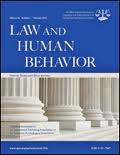 The current study provides support for the theory that concepts of openness can be used to promote disclosure among uncooperative interviewees. This is the bottom line of a recently published article in Law and Human Behavior. Below is a summary of the research and findings as well as a translation of this research into practice
The current study provides support for the theory that concepts of openness can be used to promote disclosure among uncooperative interviewees. This is the bottom line of a recently published article in Law and Human Behavior. Below is a summary of the research and findings as well as a translation of this research into practice

Featured Article | Law and Human Behavior | 2017, Vol. 41, No. 4, 333-343
A Room With a View: Setting Influences Information Disclosure in Investigative Interviews
Authors
Evan Dawson, Maria Hartwig, Laure Brimbal, and Philipp Denisenkov, John Jay College of Criminal Justice, City University of New York
Abstract
Research on embodied cognition and priming show that human behavior is influenced nonconsciously by the environment in metaphoric ways. Previous research has shown that conceptual priming can lead people to disclose sensitive information (Davis, Soref, Villalobos, & Mikulincer, 2016; Dawson, Hartwig, & Brimbal, 2015). Here, we sought to examine whether concepts of openness can be activated to promote disclosure within the interview itself, through the physical setting. In two laboratory studies, participants were exposed to details of a mock environmental terrorism conspiracy through a courier task, which they were subsequently interviewed about in different settings. In Study 1, participants were interviewed in either a room designed to activate openness, or a prototypically enclosed, bare custodial interview room. In Study 2, we manipulated both architectural and interior features of both rooms. Challenging the status quo that a small room is optimal for investigative interviewing, our findings offer compelling evidence that the spaciousness of an interview room can influence a person’s tendency to be “open” with or “closed” about information.
Keywords
investigative interviewing, embodied cognition, conceptual metaphors, disclosure
Summary of the Research
Introduction
“Interviewing is essential to collecting evidence and intelligence in criminal and national security investigations. However, eliciting information from subjects is challenging when they are not motivated to cooperate. Psychological research has examined social influence tactics that may influence an interviewee’s disclosure, however, it has not looked at the impact of the physical setting in investigative contexts specifically. Given that intelligence interviews are conducted in various field and custodial settings, our aim here is to empirically examine the influence of the physical interview context on a subject’s willingness to provide intelligence. Specifically, we test the practice-based assumption that a small interview setting promotes disclosure by promoting closeness with an interviewer against a theoretically driven hypothesis that a setting designed to promote openness will induce forthcomingness” (p. 333).
“Embodied cognition is the theory that cognition is grounded in sensorimotor experience. The embodiment hypothesis is based on the premise that our bodies and nervous systems evolved to coordinate motoric action in our environments. As such, sensory and perceptual input from the physical environment engender the most basic influences on bodily state and cognitive processes. There is a rich body of literature of embodiment effects on various cognitive processes including attention, memory, and emotion. Moreover, research supports that influences between bodily state and cognitive processes are bidirectional, and that cognition influences bodily state. For example, the physical experience of being warm influences people’s perceptions of others’ interpersonal warmth” (p. 333).
“Conceptual systems guide learning and understanding by enabling humans to categorize and make inferences and connections to previously experienced or superficially related things. Cognitive linguists contend that metaphors are a central part of the conceptual system because of their utility in concretizing abstract concepts, most of which have a perceptual basis. Metaphors, then, permit us to think and reason abstractly—with and about others—because they are grounded in common physical experience. Cognitive scientists invoke a metaphor of scaffolding to describe how elaborate conceptual structures are grounded in core structures, or primary metaphors based on early physical experience. From this view, experiences such as spatial orientation serve as basic mental structures upon which more complex concepts like time and containment are scaffolded onto” (p. 333-334).
“People commonly use the metaphor of openness when describing others communicating (e.g., “he was open about his mother, but closed up when I asked about his father”), implying that information is contained within our bodies. Two lines of empirical work suggest that the metaphor of openness is scaffolded onto primary metaphors of containment and space. Consistent with the common metaphor of our physical bodies as containers, information is understood as being held within our bodies, and disclosure involves release from such containment. From a metaphoric perspective, “keeping” or “holding” information implies that information of significance has “weight.” Indeed, research on the physical burdens of secrecy supports that “heavy” information can literally “weigh one down,” while revealing a secret can be physically unburdening” (p. 334).
“Recent empirical work on the metaphors of information as contained and disclosure as release has also examined their primary spatial components. From the perspective that metaphors in cognition are embodied, it follows logically that the (metaphoric) openness of the self may be influenced by the (literal) openness of the physical setting. In other words, researchers have hypothesized that more open spaces will lead to greater openness of the self. Research on the effects of room environment on disclosure has found that manipulating openness through the physical setting (i.e., room size and desk size) influenced participants’ perceptions of spaciousness and promoted disclosure of personal information about sensitive topics like sexual behavior, drug use, and negative emotions. Research on therapeutic settings supports that the context can influence the amount and type of information people are willing to share with others; this consideration is applicable to any context in which practitioners seek to enhance communication and make others comfortable with providing information” (p. 334).
Study 1
“Based on theories of embodied cognition and metaphoric transfer, the present study seeks to test the hypothesis that a context designed to promote openness through metaphor-consistent spatial and contextual features (e.g., pictures of open scenes, higher ceilings, greater space) will lead to more disclosure than a prototypical interview room” (p. 334).
“Participants included one hundred twelve community members from a large Northeastern city. Upon arrival to the lab, participants were tasked with delivering a flash drive that they were told contained details about an upcoming mission to a member of an environmental organization. They were asked to imagine being affiliated with the organization and informed that while most of the organization’s activities involved advocacy and protests, some members had been suspected of having committed terrorist acts. Participants then delivered the flash drive to a nearby office where a confederate was posing as an agent of the organization. The confederate informed the participant about the organization’s antifracking mission and then plugged in the flash drive, which played an audio recording that contained 26 details of a plot to bomb a natural gas operations site. After being exposed to this information, the confederate gave the participant documents to hold onto and asked them to not disclose anything. Participants then returned to the lab and were informed that they would be interviewed about their interaction” (p. 334-335).
“Half of the participants were escorted to a prototypical interview setting (“custodial setting”) and half were escorted to an interview room designed to prime openness (“open setting”). The custodial setting was a small, bare room with off-white walls, a two-way mirror with a shade drawn over the majority of it, overhead fluorescent lighting, two rigid chairs, and a small table. The open setting was a much larger room with windows and off-white walls, and it featured the following openness primes: a painting hung on each wall— on one, a picture of open water under an open sky, and on two other walls, pictures of open windows with diaphanous curtains overlooking open water and open skies; two open-top lamps; a small table with a clear, open water jug, an open cup, a small open drawer with an open lock, and an open book” (p. 335).
“Once in the interview room, participants were told that the interviewer was investigating a plot to attack a major corporation, that he knew they had met someone involved, and that the interview would concern the details of their interaction. Participants were then read interview instructions putting them in a decision-making dilemma about how much information to reveal” (p. 355).
Results
“The only observed difference in self-reported experience regarded perceived spaciousness of the room. As predicted, participants who were interviewed in the open setting viewed the room as significantly more spacious than participants interviewed in the custodial setting. Regarding actual disclosure, participants who were interviewed in the open setting provided significantly more critical and overall details about the plot than those who were interviewed in the custodial setting. Lastly, participants interviewed in the open setting were rated by coders as significantly more forthcoming than participants who were interviewed in the custodial setting” (p. 337).
“Further analyses indicated that there was an indirect effect of perceptions of room spaciousness on the number of overall details disclosed, on the number of critical details disclosed, and on ratings of forthcomingness, such that perceptions of greater spaciousness mediated the effect of the room setting, in turn increasing the odds of disclosure. In sum, the analyses show that interviewing participants in a setting designed to promote openness led them to be more forthcoming with information compared with those who were interviewed in a prototypical custodial setting” (p. 337).
“While this is promising toward effectively constructing interview rooms to facilitate disclosure in investigations, combining structural and interior manipulations presents a problem: we do not know whether the observed effects were due to the spatial layout of the room, the object primes, or both. In order to be able to advise practitioners about the optimal design of an interview room, it is necessary to separate the spatial manipulation from the interior manipulations. We therefore conducted a second study in an attempt to replicate and follow up on these findings” (p. 337).
Study 2
“The purpose of Study 2 is twofold. First, we aim to replicate the findings obtained in Study 1. Second, we examine the effect of spacious interview rooms and openness-priming objects separately in order to understand the separate and combined effects of each on the disclosure of participants. Participants included one hundred fifty-one community members from a large Northeastern city. The procedure was adapted from Study 1. When participants returned to the lab after meeting with the confederate, they were escorted to either the open setting or custodial setting room. Depending on the condition, the custodial setting and the open setting either contained or did not contain the openness primes from Study 1” (p. 337-338).
Results
“As predicted, participants who were interviewed in an open setting viewed the room as significantly more spacious than participants who were interviewed in a custodial setting. Participants who were interviewed in an open setting also wanted to leave the interview to a significantly lesser. Regarding expectations for the interview and perceptions of the interviewer, there was an unexpected main effect for the presence of primes on participants’ concerns about suspicion and perceptions of the interviewer’s suspiciousness. Regarding their interview expectations, participants who were interviewed in a setting with openness primes reported being significantly more concerned about the interviewer’s suspicion of them than participants who were interviewed in a setting without openness primes. Regarding their interview experience, participants who were interviewed in a room with openness primes reported viewing the interviewer as significantly more suspicious of them than participants interviewed in a setting without openness primes” (p. 340).
“There was a significant main effect for the spaciousness of the room on disclosure of details. Participants who were interviewed in an open setting provided significantly more overall details (but not critical details) than participants who were interviewed in a custodial setting, and participants who were interviewed in an open setting were not rated by coders as significantly more forthcoming than participants who were interviewed in a custodial setting. There were no significant main effects of openness primes as we expected or interactions between room space and openness primes on measures of information disclosure” (p. 340).
“After following up on the finding that the presence of openness primes increased concerns for and perceptions of the interviewer’s suspicion, results indicated that there was an indirect effect of perceptions of the interviewer’s suspicion on the number of overall details disclosed, on the number of critical details disclosed, and on ratings of forthcomingnes, such that perceptions of greater suspicion of the interviewer mediated the effect of the openness primes, in turn decreasing the odds of disclosure. In sum, partially replicating the findings from Study 1, the analyses show that greater spaciousness can enhance disclosure. The presence of objects symbolizing openness did not promote disclosure in either room, but instead undermined disclosure by increasing perceptions of suspicion” (p. 340).
Translating Research into Practice
“Current dogma in intelligence gathering and law enforcement contexts favors interviewing in small settings that prevent the interview subject from being comfortable. The assumptions guiding room design in manuals like the Reid technique are that isolation promotes privacy, physical closeness promotes intimacy, and drabness limits inattention; these factors are presumed to encourage disclosure while minimizing interference with one’s willingness or ability to talk. Research on factors influencing self-disclosure, particularly of sensitive or self-incriminating information, however, shows that experienced spaciousness and comfort are central to disclosing. In other words, it is when people feel as though they have freedom and space to be open that they are more likely to disclose information. Problematically, surveys of law enforcement show that isolating a suspect, particularly in a small room, is the most prevalent approach to interviewing” (p. 341).
“Intelligence and law enforcement interviewing practices are regulated in the United Kingdom, where policy mandates use of information-gathering approaches, regardless of the status of the subject. Scientific evidence supports that information-gathering approaches are more effective at eliciting information and reducing false confessions than accusatorial approaches. Complementing efforts by European governments to employ scientifically based and human rights-compliant interviewing procedures, the United States Government has supported initiatives for research and use of scientifically supported interviewing approaches. Clearly, there is motivation to improve the quality of information elicited from investigative interviews, and momentum from intelligence and law enforcement agencies, who face similar challenges in eliciting reliable information from cooperative and uncooperative subjects. Our research adds to this momentum by providing theoretically and empirically based guidelines on the optimal design of the interview room” (p. 341).
Other Interesting Tidbits for Researchers and Clinicians
“Consistent with the literature, we found an enhancing effect for openness on disclosure, but additional comparisons of various-sized rooms could help to determine the extent to which enclosure and constraint diminish disclosure. While we aimed at activating the concept of openness, theoretically, it should be possible to prime different concepts through the room setting. In addition to conceptualizing disclosure as a property of openness, disclosure has long been associated with closeness and warmth. Moreover, there is semantic overlap between these concepts that are potentially applicable to other goals of interviewing such as rapport. Building and maintaining rapport is critical to productive interviewing. Analyzing the outcomes of real terrorist interviews, researchers have found that adaptive, collaborative interviewing techniques can enhance rapport, leading to greater information yield. Hence, it may be possible to activate concepts such as warmth through contextual manipulations, which may affect the interpersonal dynamics in the interview room, and potentially promote rapport-building that can lead to disclosure” (p. 342).
“The promotion of rapport and disclosure via closeness and comfort may be especially important when manipulation of the setting’s spaciousness is infeasible. If investigators are unable to make structural alterations to the interview setting, it is beneficial to know which features may enhance an interviewee’s comfort within a constrained space, as well as those that may be counterproductive, as we observed in Study 2 with the presence of openness primes” (p. 342).
Join the Discussion
As always, please join the discussion below if you have thoughts or comments to add!







